
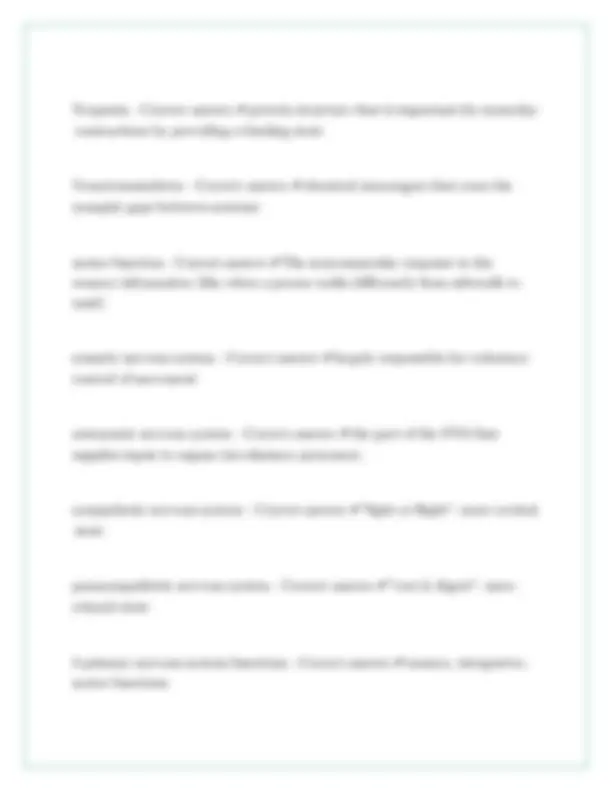
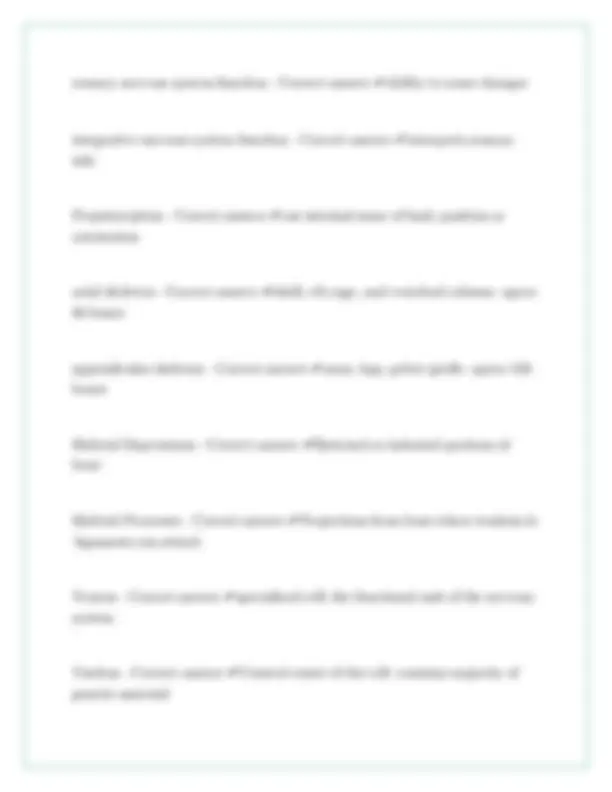
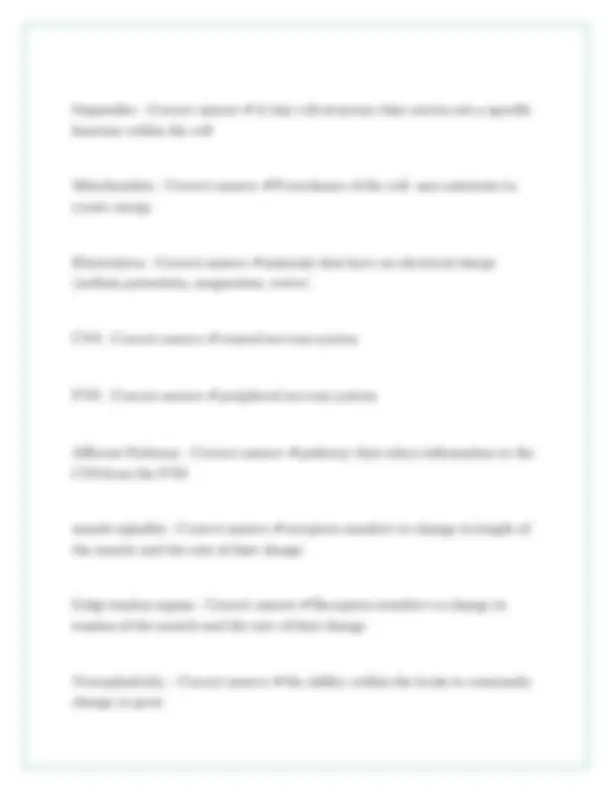
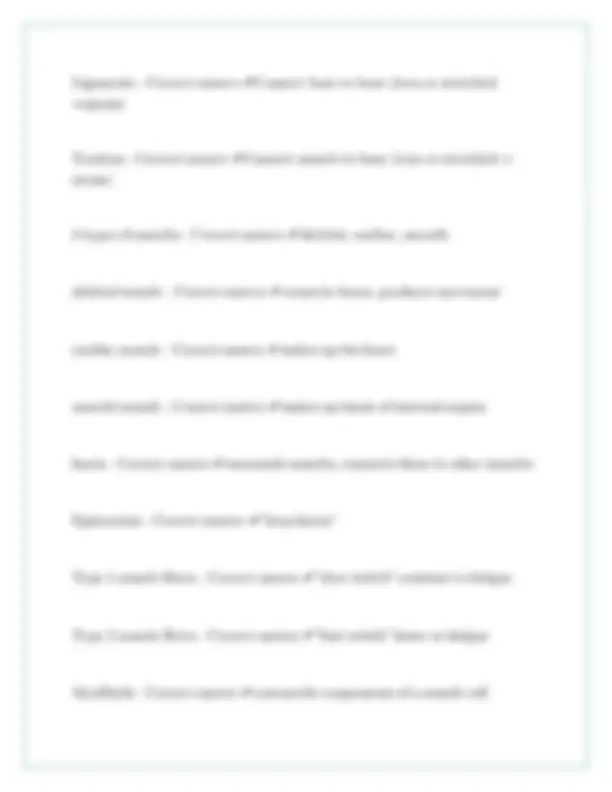
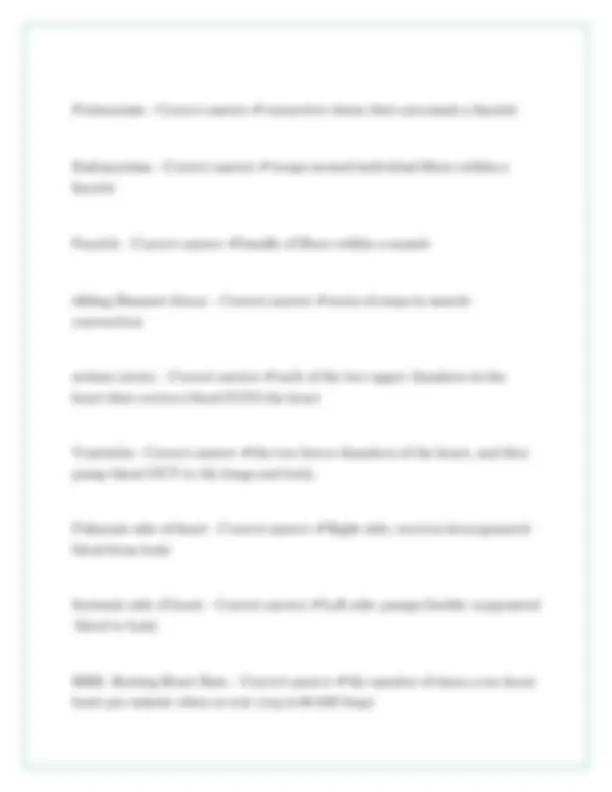
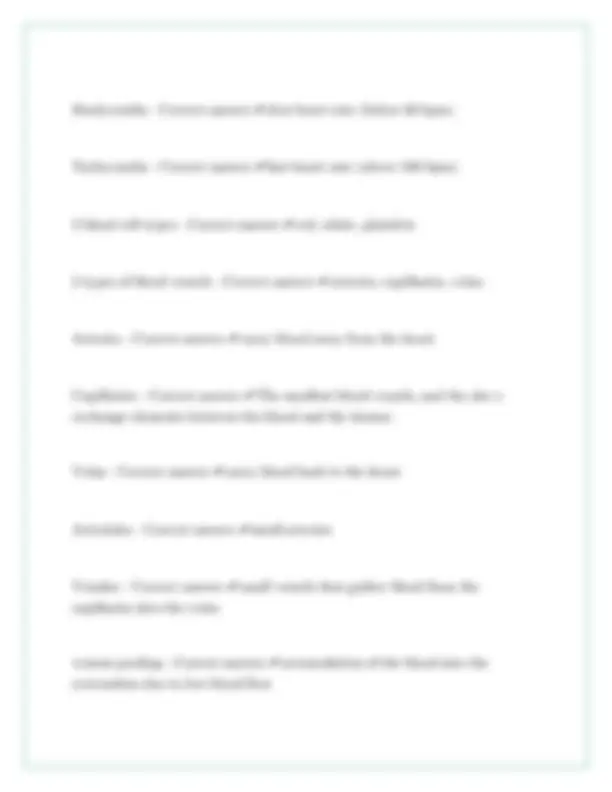


Study with the several resources on Docsity

Earn points by helping other students or get them with a premium plan


Prepare for your exams
Study with the several resources on Docsity

Earn points to download
Earn points by helping other students or get them with a premium plan
Community
Ask the community for help and clear up your study doubts
Discover the best universities in your country according to Docsity users
Free resources
Download our free guides on studying techniques, anxiety management strategies, and thesis advice from Docsity tutors
A concise overview of key concepts and definitions relevant to the nasm cpt (certified personal trainer) exam, 7th edition. It covers a range of topics including obesity, the opt model, acute and chronic diseases, cholesterol levels, diabetes, copd, the lphc, marketing principles, swot analysis, motivation types, behavior change techniques, stages of change model, smart goals, and various aspects of the nervous, skeletal, and muscular systems. It also includes information about muscle fiber types, heart function, and blood composition, making it a useful resource for exam preparation. Designed to help students quickly review and understand essential concepts for the nasm cpt exam, offering a structured approach to learning and memorization. It is particularly useful for those seeking to reinforce their knowledge and prepare for certification.
Typology: Exams
1 / 11

This page cannot be seen from the preview
Don't miss anything!







Obesity || - || Correct || answer || ✔BMI || of || 30 || or || higher Overweight || - || Correct || answer || ✔BMI || over || 25 OPT || Model || - || Correct || answer || ✔stabilization-strength || endurance-muscular || development-max || strength-power Acute || Disease || - || Correct || answer || ✔symptoms || develop || rapidly Chronic || Disease || - || Correct || answer || ✔persists || for || long || duration, || cannot || be || cured || altogether LDL || cholesterol || - || Correct || answer || ✔Bad- || Should || be || less || than || 100 HDL || cholesterol || - || Correct || answer || ✔Good- || Should || be || kept || around || 60 Type || 1 || Diabetes || - || Correct || answer || ✔Genetic- || cannot || prevented
Type || 2 || Diabetes || - || Correct || answer || ✔obesity || is || a || primary || indicator, || insulin || resistant COPD || - || Correct || answer || ✔Chronic || respiratory || dysfunctions. || Brisk || walk || can || be || one || of || the || best || forms || of || exercise || for || them. LPHC || - || Correct || answer || ✔lumbo-pelvic-hip || complex 4 || P's || of || Marketing || - || Correct || answer || ✔Product, || Price, || Place, || Promotion SWOT || Analysis || - || Correct || answer || ✔strengths, || weaknesses, || opportunities, || threats Extrinsic || Motivation || - || Correct || answer || ✔External- || for || others || or || reward Intrinsic || Motivation || - || Correct || answer || ✔Internal-- || comes || from || within BCT || - || Correct || answer || ✔Behavior || Change || Techniques- || client || interventions || that || are || used || to || change || some || determinant || of || behavior Stages || of || Change || Model || - || Correct || answer || ✔precontemplation, || contemplation, || preparation, || action, || maintenance SMART || goals || - || Correct || answer || ✔Specific, || Measurable, || Attainable, || Realistic, || Timely
sensory || nervous || system || function || - || Correct || answer || ✔ability || to || sense || changes integrative || nervous || system || function || - || Correct || answer || ✔interprets || sensory || info Proprioception || - || Correct || answer || ✔our || internal || sense || of || body || position || or || orientation axial || skeleton || - || Correct || answer || ✔skull, || rib || cage, || and || vertebral || column- || aprox || 80 || bones appendicular || skeleton || - || Correct || answer || ✔arms, || legs, || pelvic || girdle- || aprox || 126 || bones Skeletal || Depressions || - || Correct || answer || ✔flattened || or || indented || portions || of || bone Skeletal || Processes || - || Correct || answer || ✔Projections || from || bone || where || tendons || & || ligaments || can || attach Neuron || - || Correct || answer || ✔specialized || cell; || the || functional || unit || of || the || nervous || system Nucleus || - || Correct || answer || ✔Control || center || of || the || cell- || contains || majority || of || genetic || material
Organelles || - || Correct || answer || ✔A || tiny || cell || structure || that || carries || out || a || specific || function || within || the || cell Mitochondria || - || Correct || answer || ✔Powerhouse || of || the || cell- || uses || nutrients || to || create || energy Electrolytes || - || Correct || answer || ✔minerals || that || have || an || electrical || charge || (sodium || potassium, || magnesium, || water) CNS || - || Correct || answer || ✔central || nervous || system PNS || - || Correct || answer || ✔peripheral || nervous || system Afferent || Pathway || - || Correct || answer || ✔pathway || that || relays || information || to || the || CNS || from || the || PNS muscle || spindles || - || Correct || answer || ✔receptors || sensitive || to || change || in || length || of || the || muscle || and || the || rate || of || that || change Golgi || tendon || organs || - || Correct || answer || ✔Receptors || sensitive || to || change || in || tension || of || the || muscle || and || the || rate || of || that || change Neuroplasticity || - || Correct || answer || ✔the || ability || within || the || brain || to || constantly || change || or || grow
Coccyx || - || Correct || answer || ✔3-5 || small || fused || bones || (tailbone) Osteokinematics || - || Correct || answer || ✔bone || movement || (movement || of || limb) Athrokinematics || - || Correct || answer || ✔joint || movement || (roll, || slide, || spin) synovial || joints || - || Correct || answer || ✔joints || with || fluid || filled || capsule nonaxial || joints || - || Correct || answer || ✔only || one || movement- || either || back || & || forth || or || side || to || side uniaxial || joint || - || Correct || answer || ✔hinge || joint || (elbow, || toe, || ankle) saddle || joint || - || Correct || answer || ✔thumb || joint- || only || carpometacarpal pivot || joint || - || Correct || answer || ✔base || of || skull, || elbow ball || & || socket || joints || - || Correct || answer || ✔most || mobile, || movement || in || all || three || directions || (hip, || shoulder) Nonsynovial || joints || - || Correct || answer || ✔little || to || no || movement || (sutures || of || skull)
Ligaments || - || Correct || answer || ✔Connect || bone || to || bone || (torn || or || stretched || =sprain) Tendons || - || Correct || answer || ✔Connect || muscle || to || bone || (torn || or || stretched || = || strain) 3 || types || of || muscles || - || Correct || answer || ✔skeletal, || cardiac, || smooth skeletal || muscle || - || Correct || answer || ✔connects || bones, || produces || movement cardiac || muscle || - || Correct || answer || ✔makes || up || the || heart smooth || muscle || - || Correct || answer || ✔makes || up || tissue || of || internal || organs fascia || - || Correct || answer || ✔surrounds || muscles, || connects || them || to || other || muscles Epimysium || - || Correct || answer || ✔"deep || fascia" Type || 1 || muscle || fibers || - || Correct || answer || ✔"slow || twitch" || resistant || to || fatigue Type || 2 || muscle || fibers || - || Correct || answer || ✔"fast || twitch" || faster || to || fatigue Myofibrils || - || Correct || answer || ✔contractile || components || of || a || muscle || cell
Bradycardia || - || Correct || answer || ✔slow || heart || rate || (below || 60 || bpm) Tachycardia || - || Correct || answer || ✔fast || heart || rate || (above || 100 || bpm) 3 || blood || cell || types || - || Correct || answer || ✔red, || white, || platelets 3 || types || of || blood || vessels || - || Correct || answer || ✔arteries, || capillaries, || veins Arteries || - || Correct || answer || ✔carry || blood || away || from || the || heart Capillaries || - || Correct || answer || ✔The || smallest || blood || vessels, || and || the || site || o || exchange || elements || between || the || blood || and || the || tissues. Veins || - || Correct || answer || ✔carry || blood || back || to || the || heart Arterioles || - || Correct || answer || ✔small || arteries Venules || - || Correct || answer || ✔small || vessels || that || gather || blood || from || the || capillaries || into || the || veins venous || pooling || - || Correct || answer || ✔accumulation || of || the || blood || into || the || extremities || due || to || low || blood || flow
systolic || pressure || - || Correct || answer || ✔the || upper || number || in || the || fraction || that || measures || blood || pressure, || the || pressure || when || the || heart || contracts diastolic || pressure || - || Correct || answer || ✔the || lower || number || in || BP || reading, || the || pressure || when || heart || relaxes || ( || fills || with || blood || between || beats) Breathing: || inspiration || and || expiration || - || Correct || answer || ✔inspiration || is || inhale, || expiration || is || exhale Valsalva || maneuver || - || Correct || answer || ✔holding || breath || during || an || intense || muscle || contraction, || which || can || reduce || blood || flow || to || the || brain || and || cause || dizziness || or || fainting || (not || for || people || with || high || BP) Diffusion || - || Correct || answer || ✔getting || oxygen || from || environment || into || the || tissues || of || the || body Tachypnea || - || Correct || answer || ✔fast || breathing, || more || than || 24 || breaths || per || minute Bradypnea || - || Correct || answer || ✔slow || breathing, || fewer || than || 8 || breaths || per || minute Dyspnea || - || Correct || answer || ✔shortness || of || breath, || or || labored || breathing intercalated || discs || - || Correct || answer || ✔help || hold || cardiac || muscles || together